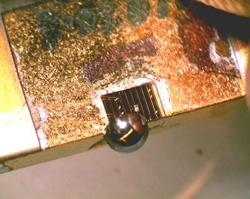
| Home | About Us | Contribute | Bookstore | Advertising | Subscribe for Free NOW! |
| News Archive | Features | Events | Recruitment | Directory |
| FREE subscription |
| Subscribe for free to receive each issue of Semiconductor Today magazine and weekly news brief. |
News
19 May 2008
First room-temperature semiconductor source of coherent terahertz radiation
Led by research associate Mikhail Belkin and professor Federico Capasso of the School of Engineering and Applied Sciences (SEAS), researchers at Harvard University have demonstrated the first room-temperature electrically pumped semiconductor source of coherent terahertz (THz) radiation (M.A. Belkin et al, Applied Physics Letters, 92, 201101). Co-authors are Feng Xie and Alexey Belyanin of Texas A&M University’s Department of Physics and Milan Fischer, Andreas Wittmann and Jérôme Faist of the Institute of Quantum Electronics at ETH, Zürich, Switzerland.
 Picture: A bar with ten THz laser sources. One of the lasers is connected to the
contact pad (on the left) by two thin gold wires. A 2mm-diameter silicon
hyper-hemispherical lens is attached to the facet of the device to collimate
the output. The emission frequency is 5THz (a wavelength of 60 microns).
Photo courtesy of the Capasso Lab, Harvard School of Engineering and Applied
Sciences.
Picture: A bar with ten THz laser sources. One of the lasers is connected to the
contact pad (on the left) by two thin gold wires. A 2mm-diameter silicon
hyper-hemispherical lens is attached to the facet of the device to collimate
the output. The emission frequency is 5THz (a wavelength of 60 microns).
Photo courtesy of the Capasso Lab, Harvard School of Engineering and Applied
Sciences.
Quantum cascade lasers (QCLs) emitting in the mid-infrared region of the spectrum were first demonstrated by Capasso and his team at Bell Labs in 1994. The compact millimeter-long lasers operate routinely at room temperature with high optical powers and are increasingly used in the commercial sector for a wide range of applications in chemical sensing and trace gas analysis. The devices are variable and tunable, allowing adjustment of the energy levels in the structure.
Extension of the emission wavelength from the mid-infrared to the ‘T-ray’ terahertz region (30-300µm) allows the radiation to penetrate efficiently through paper, clothing, cardboard, plastic and many other materials makes suits many applications. A device emitting T-rays could therefore be used to image concealed weapons, detect chemical and biological agents through sealed packages, see tumors without causing any harmful side effects, and spot defects within materials such as cracks in the Space Shuttle’s foam insulation.
However, using lasers in the terahertz spectral range (e.g. for imaging and sensing) has long presented a major hurdle, especially regarding electrically pumped THz semiconductor lasers. Such devices have required cryogenic cooling, greatly limiting their application.
To overcome the temperature limitations of current laser designs, the researchers have developed a QCL that operates in the mid-infrared at the dual wavelengths of 8.9µm and 10.5µm simultaneously, with its active region engineered to possess giant second-order nonlinear susceptibility. The consequent process of difference-frequency mixing within the laser cavity material then leads to the generation of terahertz radiation at a frequency of 5THz (a wavelength of 60µm, equating to the difference between the two mid-infrared QCL frequencies). Output power is 7µW at 80K, 1µW output at 250K, and still about 300nW output at 300K (room temperature).
“Our device emits T-rays with several hundreds of nanowatts of power at room temperature and microwatts of power at temperatures easily achievable with commercially available thermoelectric coolers,” says Belkin. “Further, there is the potential of increasing the terahertz output power to milliwatt levels by optimizing the semiconductor nanostructure of the active region and by improving the extraction efficiency of the terahertz radiation,” he reckons.
“Terahertz imaging and sensing is a very promising but relatively new technology that requires compact, portable and tunable sources to achieve widespread penetration. Our devices are an important first step in this direction,” reckons Capasso. “We believe our THz source has great development potential because the nanoscale material used was grown by molecular beam epitaxy.”
As it is based on such commercially available technology, the laser has the potential to become a standard THz source to support applications ranging from security screening to chemical sensing, it is reckoned. The researchers have filed for US patents covering the room-temperature electrically pumped THz semiconductor lasers.
The research was supported by the Air Force Office of Scientific Research and the National Science Foundation. The researchers also acknowledge support from two Harvard-based centers: the Nanoscale Science and Engineering Center and the Center for Nanoscale Systems (a member of the National Nanotechnology Infrastructure Network).
See related item:
THz QCL operating temperature raised by 10°C
Visit: http://link.aip.org/link/?APPLAB/92/201101/1
Visit: www.seas.harvard.edu/capasso